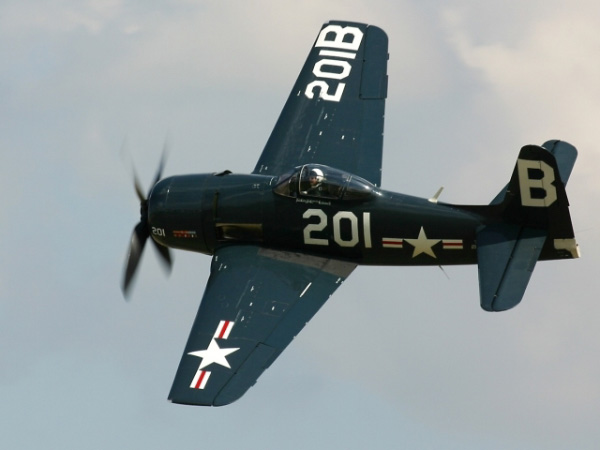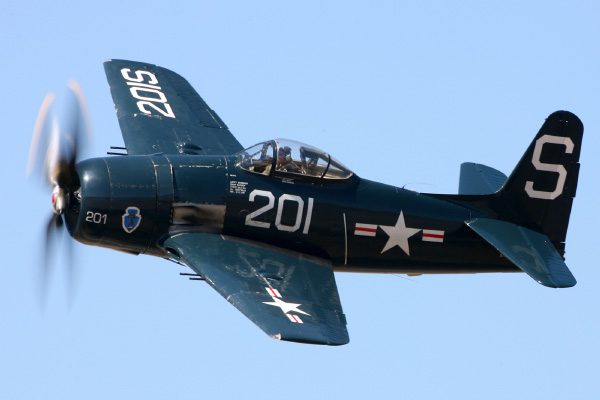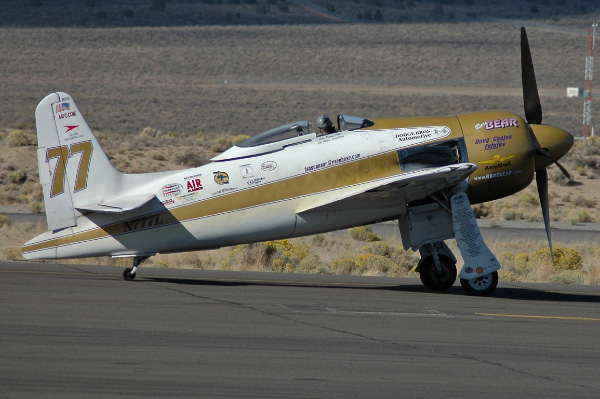
|
 |
The Grumman F8F Bearcat |
 |
 |
 |
 |
 |
|---|---|---|---|---|---|---|---|
 |
 |
 |
 |
 |
|||

|
|||
|
The Grumman F8F Bearcat was one of the best piston-engine fighters to see operational service with the US Navy. It was also the last of a series of piston-engine carrier based fighters, which had been initiated with the FF-1 of 1931. It was designed primarily as an interceptor-fighter that would operate from carriers of all sizes. It never saw see action in WWII, as it was delivered to late, but surplus Navy Bearcats played an important role in the war in Indochina with the French Armée de l'Air and the Royal Thai Air Force. Eventually, Bearcats found their way into the civilian market and were featured attractions in the Reno Air Races in Nevada. | |||
| In the summer of 1943, Grumman was now turning out large numbers of F6F Hellcats, which were seeing their first combat action in August. The design of the twin engine XF7F-1 was finalized and production would begin in October 1943.1 These two aircraft were a considerable improvement over the F4F Wildcat and were representative of the aircraft going into action for the US Navy with some emphasis on supercharged high altitude fighting. Grumman engineers working under Chief Engineer William Schwendler sought to fill a major gap in the low and medium altitude ranges for US carrier type fighters. The goal was to create a small fighter, similar to the Wildcat, but with much more speed, rate of climb, and maneuverability than any other carrier fighters in service or under development. | |||

Caption Given the Grumman designation G-58, work on the Bearcat began in 1943. It was cantilever, low-wing monoplane of all-metal construction, with the same NACA 230 series wing used in the Hellcat, that folded at about two thirds of the wing span for carrier storage. 2 It incorporated armor protection for the pilot and had self-sealing fuel tanks installed. It was more than 5 feet shorter and 2,000 lb. lighter, and had a rate of climb 30% higher than its predecessor, the F6F Hellcat. Despite being smaller and lighter, the Bearcat was still powered by the same Pratt & Whitney R-2800 engine used on the F6F and F7F. The lightweight design ensured greater performance, especially in climb, but range was necessarily compromised. To minimize drag, a heavier skin would be used with flush riveting and spot welding in some areas. Other improvements in aerodynamic design incorporated refinements in the engine cowling, leading edge intakes and a bubble canopy. Armament consisted of only four Browning M2 .50 caliber guns as this was considered adequate against the less rugged and less protected Japanese fighters.3 Armor protection and self sealing fuel tanks were sacrificed in Japanese A6M2 Zero fighters, particularly near the end of the war. Protection could not be incorporated into Zeroes powered with the 950 hp Sakae 12, and still meet armament and performance requirements.4 However, other Japanese fighters were being built with greater horsepower and performance, and the Bearcat was built with this in mind. The Bearcat had one unusual design feature to save weight, that was eventually abandoned. It incorporated provisions for Safety Wing Tips, that would break off, if the aircraft exceeded 9 Gs. This feature allowed for a lighter wing structure saving 230 lb.5 Based on experience with other aircraft, it was felt that a weak-point in the wing, would prevent the entire wing from being overstressed or failing. In addition, provisions for explosive charges were installed in the wing tips. If only one wing tip separated, the charges would be activated, to maintain flight symmetry.6 However, this feature did not always work and in two cases, a wing tip broke off during a low-altitude, high-speed pullout, and both aircraft rolled over and crashed into the sea, before either pilot could recover.7 Also, on at least one occasion, a malfunction occurred with the explosive charges during maintenance, and a US Navy technician was killed.8 Two prototypes were ordered by the Navy on November 27, 1943, with the designation XF8F-1. The first aircraft flew on August 21, 1944 (another account sets the first flight on August 13, 1944)9 and it was powered with a Pratt & Whitney R-2800-22 engine. The initial flight test met performance expectations with an initial rate of climb of 4,800 ft/min and a top speed of 424 mph.10 There was some criticism during flight testing, which included: | |||
|
1. The cockpit was cramped. 2. Lateral trim was inadequate. 3. Longitudinal trim was inadequate. 4. There was poor directional stability. 5. Airspeed indication was erratic. 6. The landing gear airspeed operation needed to be increased. 7. Provisions for six guns was requested. |
|
A dorsal fin was added to the second prototype and the request for six guns was dropped due to limitations on the aft movement of the center of gravity.
Grumman was awarded a contract for 2,023 F8F-1s on October 6, 1944 and a contract was also awarded to General Motors on February 5, 1945, for 1,876, F3M-1 Bearcats. The F3M-1 was to be powered with the R-2800-34W engine with a small increase in fuel capacity. Grumman began equipping squadron VF-19 on May 21, 1945 , but the end of the war brought a cancellation to the GM contract and the Grumman order was reduced to 770 aircraft.11 US Navy units continued replacing the Hellcats with Bearcats through 1947 and 1947 with a total of 24 units receiving the type by 1948. Grumman received an additional order of 126 F8F-1Bs with 20mm cannons replacing the .50 machine guns. fifteen of the original order were completed as F8F-1N night fighters with a radar pod located under one wing. In 1948 Grumman produced 293 F8F-2s with many improvments, such as a revised cowling, raised vertical stabilizer and rudder and with armament of 20mm cannons. Also produced were twelve F8F-2Ns as night fighters and sixty F8F-2Ps as reconnaisance aircraft. Production ended in 1949 and that same year, Bearcats were withdrawn from frontline service with the last F8F-2Ps withdrawn in 1952. Bearcats were later used as drones and designated F8F-1D and F8F-2D. In 1946, a “time to climb” record was set by an F8F, which, after a take-off run of only 115 feet, reached 10,000 feet in 94 seconds! Although it never saw combat with U.S. forces, the French used the Bearcat during their war in Indochina. The Royal Thai Air Force kept its Bearcats in service until 1960.

Caption (Image used with permission from Dare to Move.) A number of Bearcats found their way into civilian hands, and were flown as air racers. One of these, “Rare Bear”, set the world speed record for piston – engine aircraft, after hitting 528.33 mph in 1989. Of course, Rare Bear is highly modified, and is powered by a Wright R-3350 engine that generates over 4,000 horsepower!

The “Rare Bear”. Editors Note: There is conflicting information in various publications as to when work started on the F8F Bearcat and how much the Focke-Wulf Fw-190 influenced its design. In some publications, the design date is set in July of 1943, and other publications the design date is set after Grummand test pilots flew a captured Fw-190A in England, after September 1943. |
|
1. In "The Grumman F8F Bearcat" Aircraft in Profile, Volume 5 by Hal Andrews,
2. In Grumman Aircraft since 1929 by Rene J. Francillon,—LeRoy Grumman
3. In Grumman 8F8 Bearcat by Steve Ginter and "Corky" Meyer—work began
4. In United States Navy Aircraft since 1911 by Gordon Swanborough and
5. In The American Fighter by Enzo Angelucci and |
|
If you look at this list of books, it might be possible to say that all all the statements above are true, if you seperate design and production. Afterall, the first F8F didn't fly until August 21, 1944 and it is widely known that a Focke-Wulf Fw-190A was captured in 1942, when Oberleutnant Armin Faber became disorientated following a dogfight over the Bristol Channel, and mistakenly landed his Fw-190A at the RAF Pembry airfield. Although Corky Meyer flew the Bearcat throughout the F8F test program, he was only 24 years old at the time, and with the company for only six months when the Grumman team went to England. In Corky Meyer's "Flight Journal" (page 144 - Clipping the Bearcat's Wings) he stated that LeRoy Grumman, Bud Gillies and Bob Hall went to England in early 1943 to try out axis aircraft and were fascinated by the Fw190 and Hall/Gillies preferred it to the Hellcat. Perhaps to settle the argument, it would be nice to get a copy of the memo from Leroy Grumman to William Schwendler, but this still doesn't alter the assumption that military intelligence would have filtered performance data to American aircraft manufacturers by 1943 when the F8F was developed. |
| Grumman F8F Bearcat |
Specifications: | |
|---|---|---|
| F8F-1 | F8F-2 | |
| Dimensions: | ||
| Wing span: | 35 ft 6 in (10.82 m) | 35 ft 6 in (10.82 m) |
| Length: | 27 ft 8 in (8.43 m) | 27 ft 6 in (8.38 m) |
| Height: | 13 ft 2 in (4.01 m) | 13 ft 8 in (4.16 m) |
| Weights: | ||
| Empty: | 7,070 lb (3,207 kgs) | 7,690 lb (3,488 kgs) |
| Max T/O: | 12,947 lb (5,873 kgs) | 13,494 lb (6,121 kgs) |
| Performance: | ||
| Maximum Speed: | 421 mph (678 km/h) @ 19,700 ft (6,005 m) |
447 mph (719 km/h) @ 28,000 ft (8,534 m) |
| Service Ceiling: | 38,900 ft (11,857 m) | 40,700 ft (12,405 m) |
| Range: | 1,105 miles (1,778 km) | 865 miles (1,392 km) |
| Max Range: | 1,965 miles (3,162 km) | 1,435 miles (2,309 km) |
| Fuel Capacity: | 185 gal (700 liters) to 535 gal (2,0251 liters). |
185 gal (700 liters) to 335 gal (1,2681 liters) . |
| Powerplant |
One Pratt & Whitney R-2800-22W/34W , water injected 2,100 hp (1,565 kw) 18-cylinder, twin-row radial piston, air-cooled engine. |
One Pratt & Whitney R-2800-30 , supercharged 2,250 hp (1,677 kw) 18-cylinder, twin-row radial piston, air-cooled engine. |
| Armament |
Four Browning M2, 0.50 inch (12.7 mm) machine guns, and two 1000 lb (450 kg) bombs. |
Four Browning M2, 0.50 inch (12.7 mm) machine guns, and two 1000 lb (450 kg) bombs. |
Endnotes:
|
1. René J. Francillon. "Grumman F7F Tigercat." Grumman Aircraft since 1929. (London: Putman Aeronautical Books, 1989.) 236. 2. Hal Andrews. 3. 3. Hal Andrews. "The Grumman F8F Bearcat." Aircraft in Profile, Volume 5. (New York: Doubleday & Company, Inc., 1969) 3. 4. René J. Francillon, Ph.D. "The Mitsubishi A6M2 Zero-Sen". Aircraft in Profile, Volume 6. (New York: Doubleday & Company, Inc., 1970) 110. 5. Steve Ginter and Corwin "Corky" Meyer. Grumman 8F8 Bearcat (Simi Valley, California: Steve Ginter, 2008) 3. 6. Gordon Swanborough and Peter M. Bowers. United States Navy Aircraft since 1911. (Annapolis, Maryland: Naval Institute Press, 1990.) 241. 7. Steve Ginter and Corwin "Corky" Meyer. 15. 8. Steve Ginter and Corwin "Corky" Meyer. 9. Richard Thruelsen. The Grumman Story. (New York: Praeger Publishers, 1976.) 213. 10. Gordon Swanborough and Peter M. Bowers. 241. 11. Gordon Swanborough and Peter M. Bowers. 242.
David Mondey. The Concise Guide to American Aircraft of World War II. (New York: Smithmark Publishers, 1982.) 147-148. |
© Larry Dwyer. The Aviation History On-Line Museum. All rights reserved.
Updated March 27, 2010.